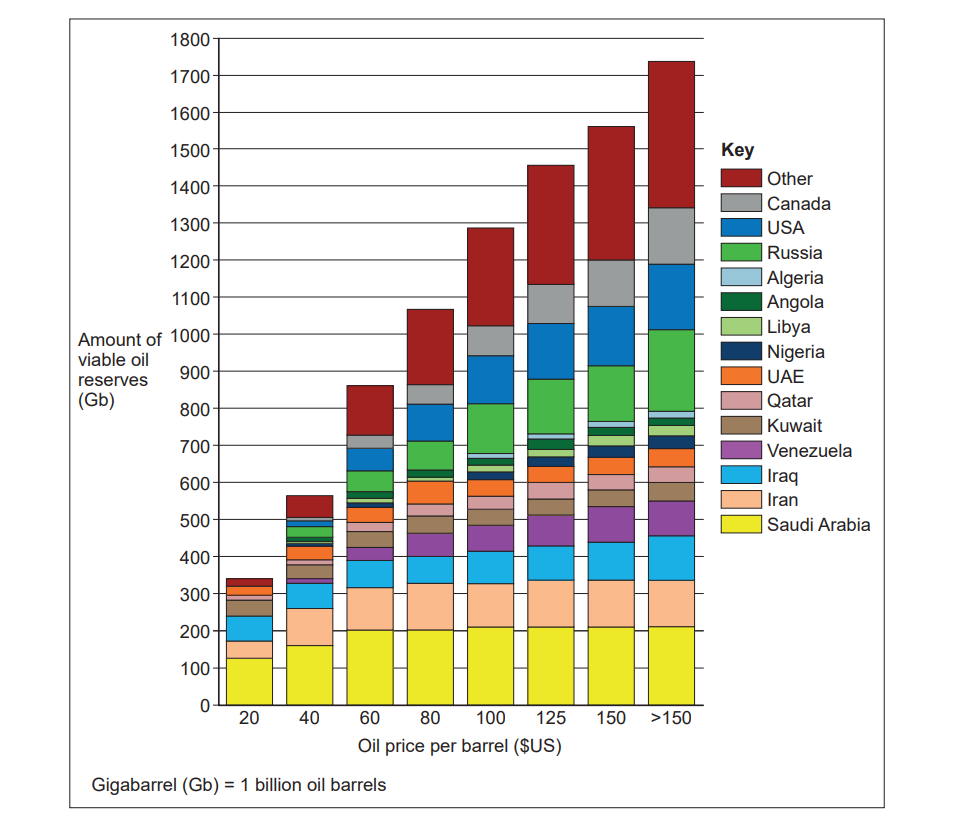Figure 12a

Figure 12b

Using Figure 12a and Figure 12b, analyse the relationship between GNI per capita and Energy consumption per capita.
[6]
Did this page help you?
Figure 12a

Figure 12b

Using Figure 12a and Figure 12b, analyse the relationship between GNI per capita and Energy consumption per capita.
[6]
Did this page help you?
Figure 13 shows trends in nuclear power and hydroelectricity consumption from 1987-2012.
Figure 13

With reference to Figure 13 and your own knowledge, assess the success of strategies to increase energy supply through developing nuclear power and renewable energy.
[9]
Did this page help you?
[4]
Did this page help you?
Figure 9a shows the location and amount of economically viable oil reserves at different oil prices in 2016.
Figure 9b shows the average oil price between January 2004 and January 2020.
Figure 9a
The location and amount of economically viable oil reserves at different oil prices in 2016
 Note: Viable oil reserves are those that can be profitably extracted.
Note: Viable oil reserves are those that can be profitably extracted.
Figure 9b

Inflation adjusted oil price graph - average oil price between January 2004 and January 2020
Did this page help you?
Figure 10a shows information produced by the Canadian government about greenhouse gas emissions and tar sand developments producing oil in Canada.
Figure 10b shows a tar sand oil production area in Alberta, Canada.
Figure 10a

Information produced by the Canadian government about greenhouse gas emissions and tar sand developments producing oil in Canada
Figure 10b

Did this page help you?
| Primary energy | Secondary energy | |
| A | A water wheel powered by a river used to drive machinery in a factory. |
Releasing radiation from uranium to convert water to steam for electricity powering a town. |
| B | Burning coal and wood in a multi-fuel stove for heat in the home. |
Gas transfer by pipeline to power a gas cooker in the home. |
| C | Production of petrol from crude oil to drive cars. |
Conversion of biogas from organic decomposition of animal waste. |
| D | Electricity generated from an HEP scheme used to power a field centre. |
Geothermal power heating ground water supplies directly into the home. |
Did this page help you?
Figure 9a shows the world’s top ten coal producing countries in 2015.
Figure 9b shows coal consumption in the top ten coal consuming countries and the rest of the world in 2015.
Figure 9c shows a Spearman’s rank calculation used to study whether there is a relationship between production and consumption of coal in the countries shown in Figure 9a.
Figure 9a
The world’s top ten coal producing countries in 2015

Figure 9b
Coal consumption in the top ten coal consuming countries and the
rest of the world in 2015

Figure 9c
The null hypothesis is: ‘There is no relationship between
production of coal and consumption of coal.’
| Rs Value | 0.806 |
|
Critical Value at 0.05 significance level (n = 10) |
0.648 |
Did this page help you?
Figure 10a shows the renewable and nuclear energy mix of selected European countries in 2012.
Figure 10b is a relief map of Europe.
Figure 10c shows average annual precipitation.
Figure 10a
The renewable and nuclear energy mix of selected European countries in 2012

Figure 10b
A relief map of Europe

Figure 10c
Average annual precipitation

Did this page help you?
[1]
Methane, helium, oxygen
Methane, hydrogen, hydrofluorocarbons
Methane, hydrofluorocarbons, carbon dioxide
Methane, carbon dioxide, hydrogen
Did this page help you?
Figure 10a shows a hydro-electric scheme in Scandale Beck, an upland river in the Lake District.
Figure 10b shows electricity generation for the scheme in selected months between 2015 and 2017.
Figure 10a

Figure 10b
| Month | Potential output (MWh) | Actual output (MWh) |
| November 2015 | 653.04 | 646.00 |
| April 2016 | 653.04 | 217.00 |
| August 2016 | 674.81 | 276.00 |
| November 2016 | 653.04 | 268.00 |
| January 2017 | 674.81 | 181.00 |
MWh = Megawatt-hours, a measure of electricity generation
Did this page help you?